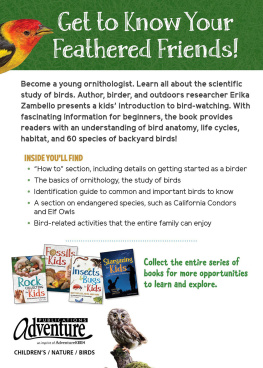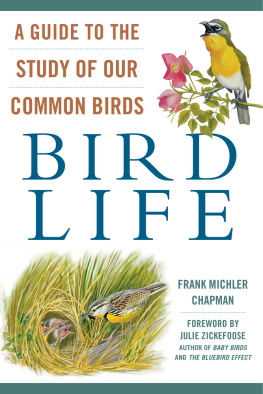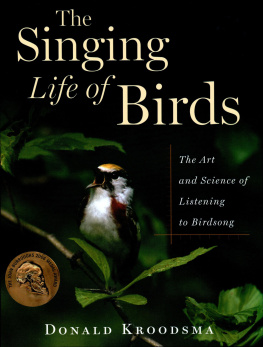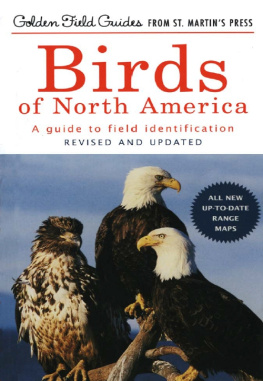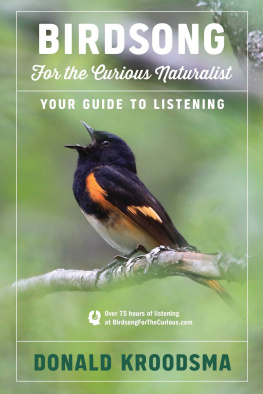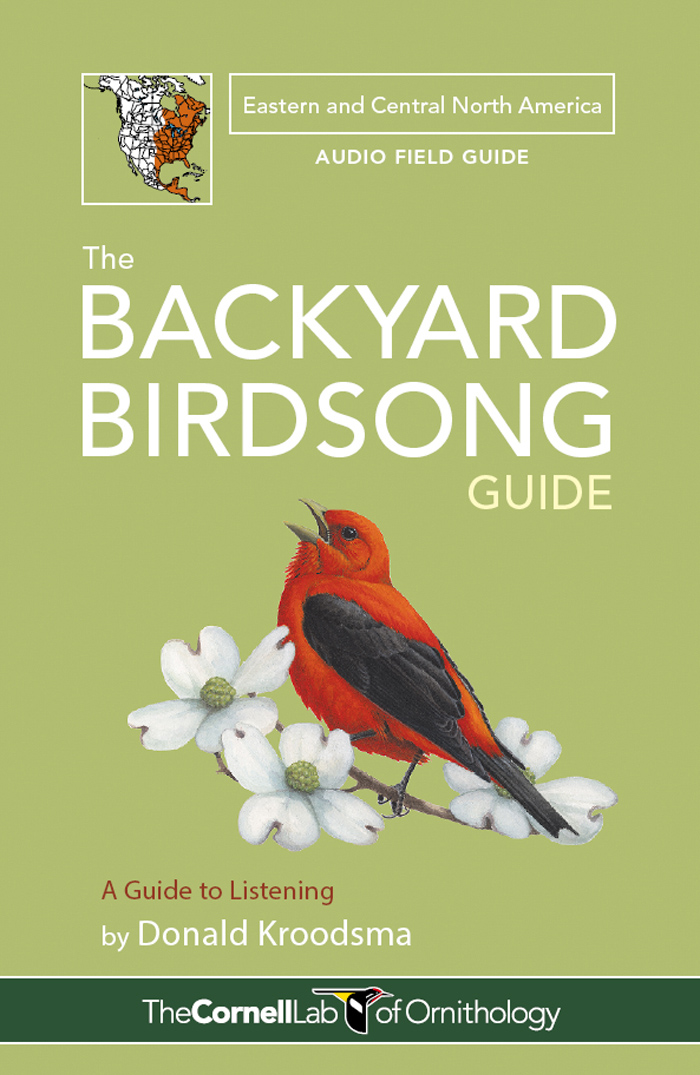
Copyright 2008 becker&mayer! LLC
Manuscript Copyright @ 2008, Donald Kroodsma
Published by arrangement with becker&mayer! LLC, Bellevue, WA www.beckermayer.com. All rights reserved. No part of this book or any subsequent editions may be reproduced, transmitted, broadcast or stored in an information retrieval system in any form or by any means, graphic, electronic or mechanical, including photocopying, taping and recording, without prior written permission from the publisher.
constitutes a continuation of the copyright page.
Library of Congress Cataloging-in-Publication Data available.
ISBN: 978-1-943645-16-9
The Backyard Birdsong Guide (Eastern and Central North America) is produced by becker&mayer!, Bellevue, Washington.
www.beckermayer.com
Front cover illustration: Jon Janosik
Back cover illustration: Larry McQueen
Audio Editing: Kate Hall
Custom Audio Engineering: Steve Beck
Design: Kasey Free, Bryan Danknich, and Joanna Price
Editorial: Meghan Cleary
Production Coordination: Leah Finger and Shirley Woo
Product Development: Peter Schumacher
10 9 8 7 6 5 4 3 2 1

Phoenix St. Claire Publishing, LLC
120A North Salem Street
Apex, NC 27502
Table of Contents
Guide
CONTENTS

P icture our planet Earth as dawns first light and a burst of birdsong sweep the globe, racing continuously and endlessly from east to west at a clip of a thousand miles per hour, repeating every twenty-four hours. In North America, imagine riding this wave of light and song as it sweeps across eastern forests, the prairies, and western mountains. A few years ago I had the opportunity to ride this wave of birdsong as my son and I biked from the Atlantic to the Pacific coast. We began our trip in Virginia in early May and rode along with the crest of the birdsong season to finish in Oregon by mid-July. On the best days, we began biking an hour or two before sunrise, feeling the power of this dawn wave approach and then pass over us.
I love the visual image of a perpetual dawn with an endless promise of a new day, but it is the aural experience that I live for. I rode across the country not with binoculars but with wide-open ears, listening to all the birds had to say, relishing their every peep. As with my human friends, I do enjoy seeing them, but Im less interested in seeing them than in hearing what is on their minds.
My hope is that youll use this book to identify birds by their appearance and also learn how to bird by ear, recognizing them by their sounds. But this book is not a mere guide to identifying particular species; no, my goal was instead to create a guide to identifying with birdsto come as close to understanding these amazing creatures as we can by interpreting the way they express themselves in calls and song.
Let me give a human analogy. Suppose you move to a small, friendly town of about a hundred people, and you want to get to know your neighbors. One approach would be to start with a mug shot and voice clip of every person so that each could be identified by sight or sound, maybe even by using binoculars at a distance of a hundred yards. Most of us, however, would find that a rather shallow experience; we might start with some pictures, but very quickly wed want to move on to more intimate experiences with selected individuals. Maybe wed linger over a lunch or go for a walk together, all the while truly listening to what is on the mind of each newfound friend. As you come to know these people, never again do you think of identifying a person or of confusing one person with another, because you know him or her so well.
This book reveals the joy in that kind of deep listening to birdsong, of coming to understand birds by how they express themselvesit is a guide to identifying with birds.


F irst, it helps to understand why birds make sounds. The great eruption of song that we hear in spring is mostly the sound of males trying to impress females. For most species, it is the male who sings and the non-singing female who chooses a mate based, in large part, on his singing prowess. A bachelor male will sing all day long, but he sings far less often after he attracts a female to pair with him. Even a paired male continues to sing throughout the spring and summer, however, because females often make additional mating choices after pairing. Although she initially chooses and pairs with a social partner to help raise her offspring, theres no guarantee that he will be the genetic father of all of her young. Its not atypical for a male to father only half of the young in his nest (as revealed by DNA fingerprinting), the other young being fathered by male neighbors who for some reason impress his mate. Thanks largely to these kinds of mating choices made by females, males continue to sing long after pairing, so throughout the spring and summer, we are eavesdropping on some of these most fundamental and complex rituals in the lives of birds.
How females make their choices remains one of the great mysteries of birdsong and is the focus of much current research. She probably listens for clues that tell something of his history: Has he been in this neighborhood long enough to learn the local dialect? Shed also do well to know his age, as older birds are more experienced and have proven that they can survive from year to year: Does there remain any hint of his babbling stage, suggesting hes just a yearling, or are his songs steady and perfect, like those of an older male? She must listen for clues to his overall health: How many different songs has he mastered, how intricate are his songs, how consistently can he sing a precise tune, or how much singing stamina does he have? Shed want to know what other males think of him, too, and how he fits into the local hierarchy of singing males: Do other males trash him by singing over him and overlapping his songs?
Whatever her standards, it is the non-singing female songbird we can thank for all of the song that we hear. Over evolutionary time, females have chosen males who sing in certain ways; those males father the offspring, who then inherit the genes to sing like their fathers or be as choosy as their mothers. She is the silent composer of the male orchestra that we hear and enjoy throughout the spring and summer.
While a primary function of birdsong is to impress females, it can serve other purposes as well. As a male sings, he announces his presence on a territory and warns other males that he will defend his space. (Singing isnt necessary for territorial defense, however, because territories in many species are defended by both males and females without song during the non-breeding season.) Its tempting for birdsong lovers to conclude that male birds sing for joy, but that is scientifically questionable for several reasons. Scientists dismiss such an anthropomorphic thought outright, for example, because it attributes human emotions to birds. The for joy explanation is also male-centered, as if he sings for himself, and I view it as an insult to every female songbird and all her female ancestors who have, by their mating choices, designed his songs and how he delivers them. In addition, if a male bird sings largely for joy, wed then have to explain why females of most species are such joyless creatures, or why males are joyful for such a short time each year. It is possible, of course, that birds experience some pleasure in singing; perhaps endorphins surge through the body of a singing bird so that it experiences something comparable to a runners high. In the end, though, its all rather simple: He sings for her.


